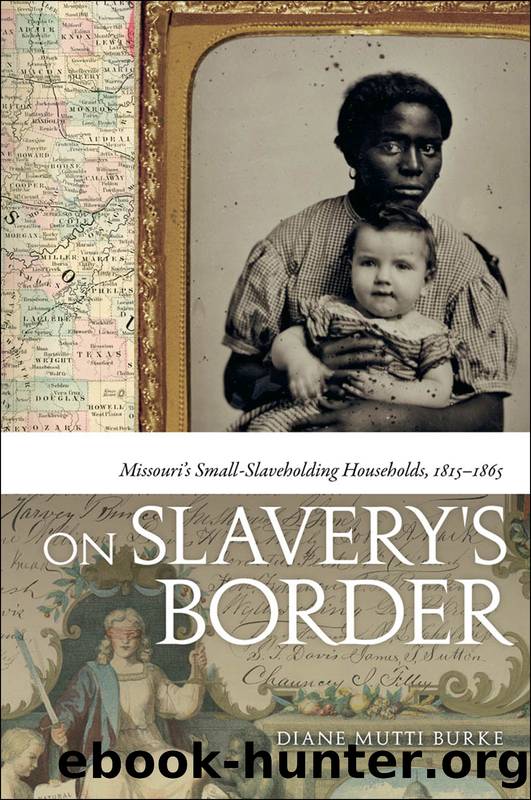On Slavery's Border by Diane Mutti Burke

Author:Diane Mutti Burke
Language: eng
Format: epub
ISBN: 978-0-8203-3736-4
Publisher: University of Georgia Press
Published: 2010-12-01T00:00:00+00:00
âWe pray that none of us will go down the riverâ
Systemic aspects of small-scale slavery had the potential to compromise the integrity of slave families in additional ways. Abroad families ultimately were more vulnerable to separation through hiring, migration, estate divisions, and sales than were their plantation counterparts because they were dependent on the life circumstances and temperaments of two owners. The often tenuous finances of small-slaveholding families might threaten the economic independence of their household and lead them to part slave families through hiring or sale.
Missouriâs pervasive system of hiring resulted in the separation of a great number of Missouri slave families, even if the arrangement was not always permanent. There was no guarantee that families would remain living together even if they were owned by the same master. Hiring created abroad families where they might not originally have existed. Mary Rollinsâs slave âGeorge objected to going to Glasgow because he would be separated from his wife.â Rollins wished that Georgeâs wife could be hired with him, âfor she requires more waiting on than her services amount to.â Children also were routinely hired away from their parents and siblings. Although small children frequently accompanied their mothers to their hiring placements, many older children were hired out on their own. Slave girls, like those employed by the Rocheport businessmen, were put out at extremely young ages to serve as domestics and nursemaids. Mary Bell remembered, âSlavery was a mighty hard life. Kitty Diggs hired me out to a Presbyterian minister when I was seven years old, to take care of three children.â Many children were placed in households where they were the only enslaved person, thus forcing them to fend for themselves without the assistance of fellow bondpeople. Although there was the possibility of visits, the emotional toll of these separations on parents and children likely was great. Most Missouri slaves were hired locally; however, in some cases, hired slaves, like those who worked on riverboats, were removed at such a great distance that it was no longer possible to regularly visit their families. Even though many slaves maintained at least some contact with kin, most viewed hiring as highly detrimental to family life. Sarah Graves commented, âMy mama was sold only once, but she was hired out many times,â making âa lot of grief for the slaves.â Not only did employers have less economic incentive to treat those they hired humanely, but they sometimes were less inclined to allow visits to family members.33
Abroad families were also vulnerable to separation when their owners migrated. Parting was most common when owners first moved to Missouri. As described earlier, countless former Missouri slaves reported forcible separations from loved ones who were left in eastern homes. Not as many families were parted by migration out of Missouri, however. As a western state largely settled during the antebellum years, there were few slaveholders who moved from Missouri, with the exception of a fairly sizable migration to Texas in the years directly before and during the Civil War.
Download
This site does not store any files on its server. We only index and link to content provided by other sites. Please contact the content providers to delete copyright contents if any and email us, we'll remove relevant links or contents immediately.
| General | Discrimination & Racism |
Nudge - Improving Decisions about Health, Wealth, and Happiness by Thaler Sunstein(7662)
iGen by Jean M. Twenge(5387)
The Fire Next Time by James Baldwin(5386)
Adulting by Kelly Williams Brown(4536)
The Sports Rules Book by Human Kinetics(4348)
The Hacking of the American Mind by Robert H. Lustig(4342)
The Ethical Slut by Janet W. Hardy(4218)
Captivate by Vanessa Van Edwards(3818)
Mummy Knew by Lisa James(3659)
In a Sunburned Country by Bill Bryson(3509)
The Worm at the Core by Sheldon Solomon(3457)
Ants Among Elephants by Sujatha Gidla(3442)
The 48 laws of power by Robert Greene & Joost Elffers(3150)
Suicide: A Study in Sociology by Emile Durkheim(2990)
The Slow Fix: Solve Problems, Work Smarter, and Live Better In a World Addicted to Speed by Carl Honore(2979)
The Tipping Point by Malcolm Gladwell(2874)
Humans of New York by Brandon Stanton(2848)
Handbook of Forensic Sociology and Psychology by Stephen J. Morewitz & Mark L. Goldstein(2679)
The Happy Hooker by Xaviera Hollander(2673)
